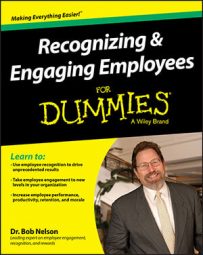The link between employee recognition and employee engagement occurs on several levels: first, through reinforcing specific desired behaviors; second, through recognizing specific desired results; and third, through recognizing specific desired end states — that is, the environmental culture and core values you’d most like your company to be known for. The following table shows typical engagement behaviors and provides examples of ways you can recognize those behaviors.
| Desired Type of Engaged Behaviors by Employees | Potential Recognition Activity to Deploy |
|---|---|
| Understanding corporate mission | Use photos, videos, and stories to recognize examples of work that tie into the mission with |
| Understanding professional expectations | Support question asking; create quizzes and contests about job descriptions |
| Providing input on workplace matters | Solicit and thank employees regularly for input; make sure upper management is present during key discussions and meetings |
| Making suggestions | Actively solicit and recognize ideas, and give employees the autonomy to try them; trumpet successes and “successful failures” |
| Engaging in teamwork and collaboration | Recognize team progress; celebrate milestones and final achievements |
| Taking initiative | Recognize proactivity and those who ask questions; support extra efforts by allowing flex time and more resources |
| Quality work and/or service | Recognize attaining quality standards, error reductions, client satisfaction scores, and positive customer feedback |
| Problem solving | Recognize creative group processes, brainstorming, and innovative solutions |
| Bonding with manager and building relationships | Encourage face time and learning about each other by making common areas available |
| Connecting with others | Hold recognition celebrations and town hall meetings; provide networking opportunities by increased access with others |
| Learning and developing skills | Host games and friendly competitions that are based on workplace and professional skills |
| Participating in career development | Offer workshops, mentorship programs, and time off and/or funding so employees can attend seminars |
| Pursuing career paths | Give employees job variety, opportunities, and professional movement |
| Showing excitement and having fun | Hold celebrations and parties |

